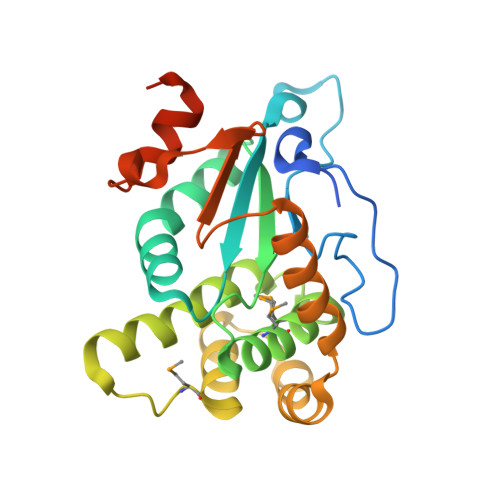A Disulfide Bond-forming Machine Is Linked to the Sortase-mediated Pilus Assembly Pathway in the Gram-positive Bacterium Actinomyces oris.
Reardon-Robinson, M.E., Osipiuk, J., Chang, C., Wu, C., Jooya, N., Joachimiak, A., Das, A., Ton-That, H.(2015) J Biol Chem 290: 21393-21405
- PubMed: 26170452
- DOI: https://doi.org/10.1074/jbc.M115.672253
- Primary Citation of Related Structures:
4Z7X - PubMed Abstract:
Export of cell surface pilins in Gram-positive bacteria likely occurs by the translocation of unfolded precursor polypeptides; however, how the unfolded pilins gain their native conformation is presently unknown. Here, we present physiological studies to demonstrate that the FimA pilin of Actinomyces oris contains two disulfide bonds. Alanine substitution of cysteine residues forming the C-terminal disulfide bridge abrogates pilus assembly, in turn eliminating biofilm formation and polymicrobial interaction. Transposon mutagenesis of A. oris yielded a mutant defective in adherence to Streptococcus oralis, and revealed the essential role of a vitamin K epoxide reductase (VKOR) gene in pilus assembly. Targeted deletion of vkor results in the same defects, which are rescued by ectopic expression of VKOR, but not a mutant containing an alanine substitution in its conserved CXXC motif. Depletion of mdbA, which encodes a membrane-bound thiol-disulfide oxidoreductase, abrogates pilus assembly and alters cell morphology. Remarkably, overexpression of MdbA or a counterpart from Corynebacterium diphtheriae, rescues the Δvkor mutant. By alkylation assays, we demonstrate that VKOR is required for MdbA reoxidation. Furthermore, crystallographic studies reveal that A. oris MdbA harbors a thioredoxin-like fold with the conserved CXXC active site. Consistently, each MdbA enzyme catalyzes proper disulfide bond formation within FimA in vitro that requires the catalytic CXXC motif. Because the majority of signal peptide-containing proteins encoded by A. oris possess multiple Cys residues, we propose that MdbA and VKOR constitute a major folding machine for the secretome of this organism. This oxidative protein folding pathway may be a common feature in Actinobacteria.
Organizational Affiliation:
From the Department of Microbiology and Molecular Genetics, University of Texas Health Science Center, Houston, Texas 77030.
















